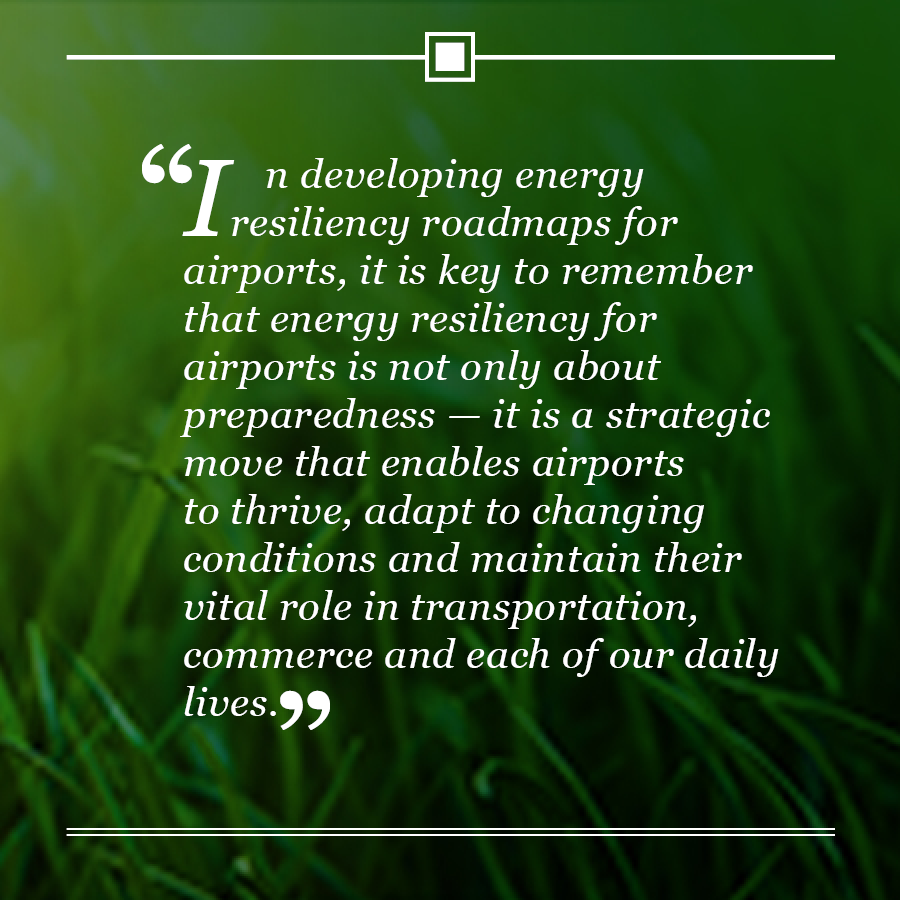
Energy resiliency plays a crucial role in ensuring the smooth operation and sustainability of airports and is critical to continuity of operations, safety and security, economic impact and more. As stated in the Airport Cooperative Research Program’s (ACRP) Research Report 260: Airport Energy Resiliency Roadmap draft, which will be officially published this month, “As key infrastructure in today’s interconnected economy, the airport and its operations are critical to local, national, and international communities. Ensuring the continued operations of the airport, despite near-term disruptive events or longer-term shifts in energy supply and demand, is vital to meeting customers’ needs. Pursuing energy resiliency-the ability to withstand, adapt to, and overcome changes or impacts to the energy landscape across multiple time frames, whether caused by deliberate attacks, accidents, or naturally occurring events-ensures public safety, positions the airport as a community leader, and enhances its brand.”
Hanson assisted the Transportation Research Board’s ACRP in developing a primer on energy resilience for airport executives and a guidebook on creating an energy resiliency roadmap for their airports. The objective of the project was to prepare a resource for airports to use as they work to meet their customers’ ever-changing energy and operational needs while improving each airport’s energy resiliency and achieving sustainability.
When thinking about energy resiliency, it is important to differentiate between planning for and mitigating short-term interruptions (e.g., weather events or targeted attacks) and long-term resiliency, which may require a larger initiative encompassing years of planning, development and deployment that is focused on forecasting demand and preparing for higher energy use and grid infrastructure, which may not be reliable for 100% uptime.

The planning should also acknowledge that energy resiliency and sustainability are distinct concepts that can be achieved independently or jointly, depending on the strategy and goals set during initiation. The interplay between sustainability and resiliency should be discussed during the creation of the energy resiliency roadmap, with a focus on the tradeoffs when prioritizing one over the other, as well as the possibility of achieving both.
The processes for achieving energy resiliency should engage internal and external stakeholders early in the development process and ensure the roadmap aligns with other goals and initiatives and incorporates a broad range of perspectives on impactful resilience goals. The process should also identify an energy baseline by calculating demand, understand supply and identify vulnerabilities. Prior to identifying strategies to address resiliency gaps, the airport should establish foundational goals and identify tools or levers that can be used to implement strategies to accomplish the energy resiliency goals. For each foundational goal and associated lever in the roadmap, an airport should identify specific energy resiliency strategies and a timeline to progress toward the goal. The airport should also realize that workforce changes may be necessary to implement an energy resiliency roadmap and could vary from hiring additional information technology staff to retraining staff who currently support fossil fuel systems to service clean-energy systems.
In developing energy resiliency roadmaps for airports, it is key to remember that energy resiliency for airports is not only about preparedness — it is a strategic move that enables airports to thrive, adapt to changing conditions and maintain their vital role in transportation, commerce and each of our daily lives.
To learn more about ACRP Research Report 260, contact Susan Zellers at szellers@hanson-inc.com or Bill Bradford at bbradford@hanson-inc.com.